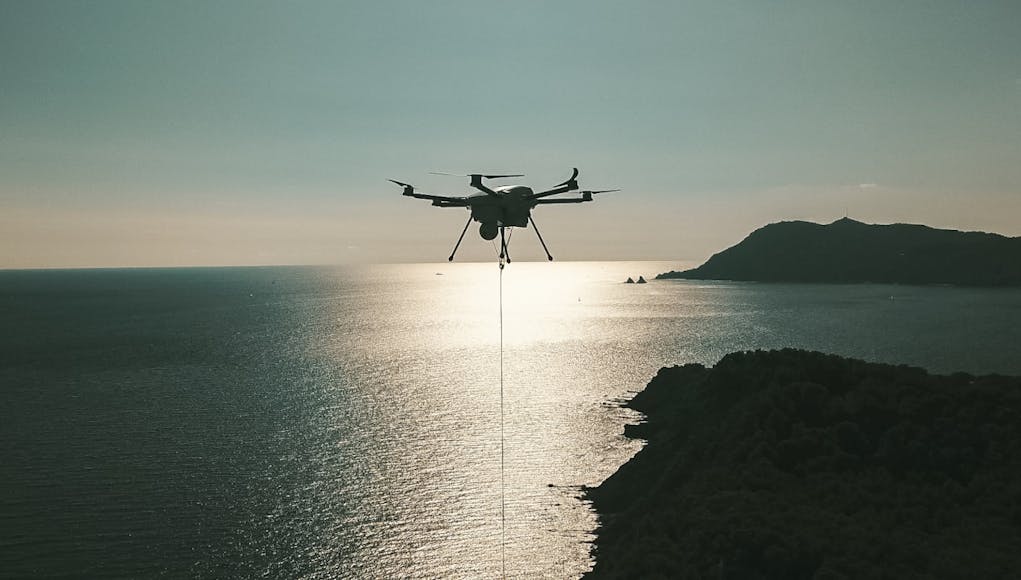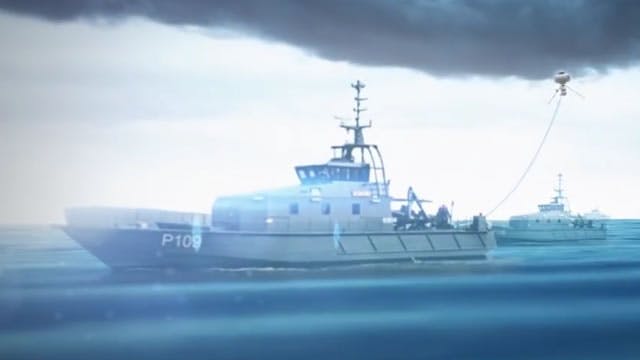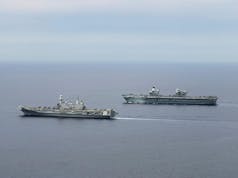Britain is looking to spend £458k on two tethered Uncrewed Air Systems for the Royal Navy with a flight time of 24 hours, a maximum payload of 25kg and operational height of 90 metres.
The Ministry of Defence say in a contract tender notice that un-crewed Air Vehicles operating under battery power “currently offer limited flight duration”.
The solution? They’re now looking for:
“A UAV system operating from a Tethered power supply is sought to allow considerably increased flight duration. The ability to flexibly integrate differing payloads is key to allow the UAS to operate as a platform for trials and testing.”
Specifically, the contract tender is for the supply of 2x Un-crewed Air Vehicles, with 2x compatible tethered power supplies, control interfaces and replacement batteries for use as experimentation and payload integration platforms by the Royal Navy.
“The Supplier shall provide 2x complete Tethered Un-Crewed Air Vehicles compliant with the mandatory requirements given above and the documentation as described above by 31 March 2022. Delivery shall take place to NavyX HMNB Portsmouth, UK.
Each complete Tethered UAV system will consist of the following as a minimum.
- Un-Crewed Air Vehicle including 2x rechargeable batteries for operation in a non-tethered mode.
- UAV handheld control interface including 2x rechargeable batteries.
- Tethered power unit and cable.
- Battery chargers for all provided batteries.
- Protective transport casings for the above.
- DTC IP MESH NETNODE 2X5W-5RM Radio with associated omni-directional antenna and mounting plate”
Chris, CO Rotary Wing Test & Eval Sqn and previous CO 820 NAS, told me on Twitter:
“I started this when I was the MARCAP desk officer. I’m really excited to see it still progressing as I think there is so much merit here. Increased Mast Height for sensors, able to maintain station over the host vessel or move out of the way if required. What’s not to like?“
What is a Tethered UAS?
A tethered UAS is one where the unmanned aircraft remains securely attached (tethered) via a physical link to a person, the ground or an object at all times while it is flying. The tether normally takes the form of a flexible wire or a cable and may also include the power supply to the aircraft as well.
The below image shows a concept image for a naval Tethered-UAS and how it might operate.
Operations with a tethered UAS can be used as an efficient solution in a number of cases, for example where an operating area is restricted, or when the required flight time exceeds the normal endurance of a free-flying battery-powered aircraft.
What kind of specifications are outlined in the tender notice?
According to the contract notice:
- The Tethered UAV is to be able to lift a minimum payload of 1kg. Vendors will be awarded additional points for maximising the payload weight not exceeding the maximum 25kg UAM.
- UAV will be capable of 24 Hours continuous flight time while operating from Tether.
- UAV will be capable of 10 minutes continuous flight time while operating from battery to allow emergency landing in event of a loss of power supply from Tether Unit.
- UAV will be capable of 10 minutes continuous flight time while operating from battery to allow emergency landing in event of a loss of power supply from Tether Unit.
- Can Supply live imagery transmission to third party hardware via a recognised output. i.e. HDMI or ethernet
- The UAV to maintain an unmonitored geospatially relative position in relation to the tether unit on a moving platform without visual aid.
What kind of payloads are they thinking about?
Again, according to the contract notice:
- The Supplier is to work with the authority to develop a MANET compliant payload with associated omni-directional antenna and mounting plate to each UAV.
- The UAV shall be capable of mounting an optional payload of a Gimbled 30x Visual Daylight Camera.
- The UAV shall be capable of mounting an optional payload of a Gimbled HD Thermal Camera.
- The UAV shall be capable of mounting an optional payload of a Gimbled Dual Daylight/Thermal Camera.
When will the system be delivered?
Delivery of the system and associated documentation is planned for the 31st March 2022. The tendering period closes 19th January 2022, 10am.















mini aerosat? for OPVs, the Scan Eagle RM1 have 24Hrs+ endurance could be launched/recovered from everything from OPV up, surely it is better option?
No batteries = larger payload + indefinate endurance. Useful for force protection in restricted airspace – like in port, also gives you a much further horizon for your shipboard EO/IR devices. The teathered drones use inputs from the ship controls to follow the ship. Compared with Scan Eagle they are very cheap and can be launched in harbour and restricted / commercial airspace which is most of the airspace around the UK, can also be used by small patrol boats, USVs or even on RHIBs. The Navy is also aquiring larger VSTOL UAS for the job of longer ranged suveillance.
A better way of seeing them is as a method to make the mast a lot taller, rather than as a conventional UAV.
Hi James, yes i understand but i don’t know of many ports which are that big that the horizon is beyond range of a cam of this size if mounted on the mast (can’t find B2 mast height) but 20M mast will detact to about 20KM for speedboat size (i think happy to be corrected) but the can’t be operated in rough conditions the heaving motion would mean much stronger/heavier cabled, more power (bigger/heavier motors) needed to keep aloft.
“can’t be operated in rough conditions the heaving motion would mean much stronger/heavier cabled, more power (bigger/heavier motors) needed to keep aloft”
That was exactly the 1980’s experience.
So although better tech will enable the tethers to be lighter – kevlar etc springs to mind.
Physics, ie pure mass, is still a limiting factor.
And someone would still have too operate the winch , or start an on-board kite flying club
To be honest that can probably be automated now.
The main barriers to height are mass (weight) of tether.
It will also be useless in a moderate to high sea state as the dynamic forces from the tether to the flying platform become unmanageable.
And we know what it’s like trying too fly a Kite in windy conditions best have the workboat crew at standby at least they won’t have too pipe no smoking aft of the Bridge Flying stations or a FOD plod
As there will be no need for the cable to be tight, unlike a kite, then it might be less of an issue, as you could have a lot of slack in the cable to allow for the movement of the ship. The cable just be passing power/data and not controlling the flight I assume.
It will still be a catenary cable.
So the reactions are well understood.
The thing with a catenary is that it amplifies forces. Sure with interactive control you can mitigate this.
Anyone who has spent 5 mins at sea will realise that the issue is the sheer lack of unpredictability if which way the ship gets tossed around. The sea is not a nice consistent surface: odd waves…..
Yeah but a catenary cable still mitigates a lot of that movement, for sure not 100% but a decent amount. Then it just comes down to the lift lower of the drone and the computers onboard to mitigate this, just like they do with changing winds. Not easy but with modern drone tech it should be viable.
They don’t need a winch – they are still UAS – they fly. They just need a reel like on your vacuum cleaner lead.
Reel or winch both run out and in we called them winch reels were for fishing its a Seaman’s terminology
Winch is powered, a reel not so.
I simply don’t understand what they are trying to achieve with this?
The sensors that they are looking at are all low rent and can be fitted to 4hr+ duration commercial drones.
So all you need are three of the commercial drones to use in rotation.
90m is not that high. QEC mast is 73m so this doesn’t offer a lot more.
As others have previously stated: this was tested out a lot on the 1980’s and dumped. Mainly because to get to a useful height the cables get too heavy and the danger of the thing crashing downwards if something goes wrong.
OK here there is a battery soft land option but overall it is not confidence inspiring.
This really sounds like an OPV adjunct for ant drugs or piracy rather than anything that would be of use to a CSG or for war fighting.
I get that a bigger aerial is always a better aerial but even so? Unless you need the much longer aerial for phased ULF in the field?
Ultimately the plan is to find a way of making the mast taller – to elevate the ship’s sensors and provide a wider horizon. This is a step along the way which is useful for littoral force protection and offshore patrol tasks..
It’s not designed for QNLZ – and you can’t put QNLZ’s mast on an OPV.
Ergo, if the UAS does not have to carry batteries it can carry a larger payload
Thank you James I was going to make the exact same points. 80s technology hardly bears comparison to 20s tech but equally without tests of this nature you will never be able to judge what present te h offers but more importantly what potential to develop it in the future is. I’m really glad to be hearing about a number of these sort of tests to determine if it can be worth exploiting and pursuing especially as we so often hear criticism of us being late to the game even when tech has not proven its worth.
If it is on a wire the information is 100% secure as it cannot be blocked or intercepted. Commercial drones may as well broadcast their footage on Facebook live for the enemy to enjoy a good watch as well
True if using fibre.
I was referring to a COTS platform with bespoke payload and comms.
Kinda depends what sensors they are going to fit within the 25kg weight limit. If it’s just a camera, I’m struggling to understand the real world use of it. Would up identification range a little, but not significantly
Likewise.
The camera range is usually limited by conditions not curvature of earth anyway.
More experimentation.
Several years from now they will experiment with something else.
The novelty of actually buying something that works, is proven, is in service, and in numbers will be too much!
” buying something that works, is proven” Since 1924 😂
😂
😝
Nice one Nigel. 😂
The Navy in the latter stages of the Great War did put balloons tethered aloft for AS work in the Channel
And we might just do that in future with a sting in the tail!
UK Navy’s futuristic plans include helium balloon attack craft and coral submarines
https://www.thenationalnews.com/world/uk-news/2021/09/13/uk-navys-futuristic-plans-include-helium-balloon-attack-craft-and-coral-submarines/
Cheers Nigel it seems we still have backroom boffins lurking somewhere usually gardensheds
I’ll take a look 😂
You laugh, but there are more up to date versions than that. This one is British, secured $200m in equity finance last year, has three production orders, and the original military version won a now defunct competition for the US Army against Lockheed Martin and Northrop Grumman.
And even if our navy isn’t interested, others may be
Of course only being credited with lifting a maximum of 25kg as detailed in the spec is an issue; its payload is measured in tons and it’s expected to cost around £35m a pop.
Prototypes have been flying since 2012, and full production models are expected to be in the air by 2023. Want to bet whether the RN will even get a first test model of this tethered drone first?
“You laugh” Some did as it was intended as a joke!
Yes but this is British industry – buying foreign systems OTS is not good for strategic resilience. At least the Navy is now moving purposefully from experimentation towards a capability – as with uncrewed mine countermeasures and XLUUVs. In the past a few large and expensive experimental capabilities would be funded and then disappear into the funding black hole – like the SOLO VSTOL UAS, or many others like Triton. The same with other services (Taranis or Fire Shadow anyone). Starting small and cheap and working up to a full blown capability seems a good strategy, rather than putting all of your R&D eggs in one uncrewed basket.
I agree, if we buy something that is proven and in service then by definition others have proved more innovative and far sighted than we have and developed those ideas to production level, which surely is one of the big criticisms of uk defence policy over the years. You have to experiment to discover what does or doesn’t work and that’s as well as in many cases simply applying what others have developed that suits their own circumstances which may or may not be relevant to ours..
We know they are having problems with Crowsnest. Need I stay more?
Really. do tell?
This is about as related to Crowsnest as the pidgins in Trafalgar square are.
There is no radar emission capability or anything else specified here.
Well they are having problems with Crowsnest but this particular requirement won’t have any effect on that the payload is tiny and not really relevant to major warships which would use much larger and free flying drones to match, exceed or replace that programme and even then years in the future.
FA330 Mk 27.
Is that the tethered gyrocopter they used to fly off the back of surfaced U-boats for spotting in WW2?
I saw one at the RAF museum in Cosford last summer. I have to hand it to the pilots, they must have had cajones made from unobtanium.
I always think that hanging a blimp or wot ever above a ship, at height, is simply akin to waving a flag above said ship making it much more detectable/visible at a distance? AA
Yes a blimp these days would likely be, though their proponents do claim that they can be made very low profile to radar. However a small drone is a completely different beast, which is why so much effort is being made to detect and nullify them even on the battlefield. Indeed I do wonder if this proposal might have an eventual use in detecting drones for smaller vessels.
I doubt this is supposed to be a Crowsnest replacement! In the case of a patrol vessel undertaking a search or doing a coastal survey, visibility isn’t an issue.
I wonder what the future holds?
UK Navy’s futuristic plans include helium balloon attack craft and coral submarines
https://www.thenationalnews.com/world/uk-news/2021/09/13/uk-navys-futuristic-plans-include-helium-balloon-attack-craft-and-coral-submarines/
And piecrete Aircraft carriers as thought of during the Battle of the Atlantic virtually indestructible bur would melt in the trooics
Never understood the Battery power when we have small gas turbines that can give far longer duration and power radar and other relatively power hungry sensors. VTOL like capabilities and can operate say 50 miles away from ship maybe based upon V-22 technology in a far smaller scale say the size of the old Wasp Helicopters
Essentially a modernised version of the WW2 German Focke-Achgelis Fa 330
Would a fixed wing kite/glider/uav that can stay loft at various speeds using adapatabe wing be better? only need small engine to provide enough fwd momemtum to fly at min wing speed and then only if ship is still with no wind?
just a thought wing can always carry heavier payload than rotors just whether the wing would/can be effective at 10-15kts? something like a towed Fixed-Wing VTOL UAV
I’ve often pondered whether a high altitude tethered drone/lighter than air vehicle could be used as an alternative to the Crowsnest merlins?
If it emits a radar signal then it pretty much pinpoints the location of the ship for a missile strike.
I did wonder about whether it would make it easier to work out where the ship is. Thank you.
Sure, but why tether it? It doesn’t need continuous power to stay aloft. An airship could maintain station for weeks, within a carrier groups’ defensive missile envelope, but miles away from the command ship.
The problem with Crowsnest isn’t just the fact that a helicopter is a terrible platform for it. The radar sucks too. Whether the “incremental improvements” between now and the end of 2023 will make it even partly fit for purpose is unknown. The amount of money available for the AEW solution simply isn’t enough.
An airship costs a similar amount to a helicopter to buy, although I imagine it would be much cheaper to run. Nevertheless there’s no money to buy new helicopetrs, so no money to buy new airships. And that still doesn’t get around the sucky radar.
The Crowsnest interim replacement/enhancement projects were only to be awarded £250,000 for proof of concept. So it’ll be interesting if anyone can make that fly.
Sorry, I’m being thick here. If it’s going to be tethered, isn’t an inflatable/deflatable payload carrying balloon better? I suppose helium storage might be an issue? Just wondering
Considering they have been looking into this type of UAV for a few years, again its slow progress as usual🤔
A 21c version of a Focke-Achgelis Fa 330……although the Second World War version used lift generated by the movement of the boat and could carry a pilot just with that, no batteries or electric tether needed. But the mother ship needs to be moving so….
Precursor to the AEW Aerostat that will be deployed on the Type 83 Destroyers?
It would be interesting to know how heavy is the radar in an f35 /crowsnest.
Get 25 kg to 90 metres height, hope they do a comparison with hauling a kite obviously the ship has to be moving. Perhaps without self power the landing is too heavy for delicate sensors.